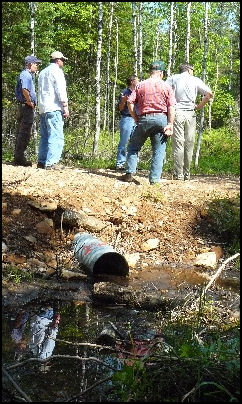| Introduction | Forest Types | |
| Forest Characteristics | Management | |
| Forest Contributions | Special Considerations | |
| The Forest Plan | Assistance |
![]()
FOREST MANAGEMENT GUIDELINES FOR MICHIGAN |
| Introduction | Forest Types | |
| Forest Characteristics | Management | |
| Forest Contributions | Special Considerations | |
| The Forest Plan | Assistance |
![]()
FOREST MANAGEMENT GUIDELINES FOR MICHIGAN |
Special Management Considerations
[Back to main page for special considerations]
Road Construction and Maintenance
Properly planned, constructed, and maintained roads are an asset to forest properties for many uses. Access is necessary for harvest, regeneration, protection, other management activities, and recreational uses of forest land. On occasion, excluding access is also appropriate when objectives such as protecting sensitive areas or maintaining semi-primitive and wilderness areas are important concerns. However, improperly constructed roads have the potential for negative impact on biological and physical components of forest ecosystems.
Access roads should be carefully laid out before construction. Tools such as aerial photographs, soil surveys, and topographic maps should be consulted to help in locating roads away from sensitive areas. Objectives of forest land ownership, frequency of access, types of vehicles to be used, and the relative ease of road building under existing conditions of soil, terrain, and finances should all be considered when planning a permanent road system. Professional assistance is often required since improper location, design, and construction of roads is the greatest source of soil erosion on forest lands. Permits may be needed for long distance haul roads or for roads that are constructed within 500 feet of a lake or stream (Public Act 451, Part 91).
 Roads should be adequately designed to accommodate the type of use they will receive. Main access routes and haul roads should be ditched and sloped to provide for adequate drainage. They should be graveled under most conditions. Use of geotextile cloth and other erosion control products are also very useful in constructing durable, serviceable roads. Secondary and temporary roads can be narrower and seeded to native herbaceous cover after use in order to prevent erosion and to provide food for wildlife. Roads over wet soils should be limited to the shortest length possible, re‑routed to upland areas, or developed for use only when frozen.
Roads should be adequately designed to accommodate the type of use they will receive. Main access routes and haul roads should be ditched and sloped to provide for adequate drainage. They should be graveled under most conditions. Use of geotextile cloth and other erosion control products are also very useful in constructing durable, serviceable roads. Secondary and temporary roads can be narrower and seeded to native herbaceous cover after use in order to prevent erosion and to provide food for wildlife. Roads over wet soils should be limited to the shortest length possible, re‑routed to upland areas, or developed for use only when frozen.
Stream crossings require bridges or culverts of a size sufficient to handle stream flow especially during the spring thaw and normal floods. Temporary and permanent stream crossing permits are required under Public Act 451, Part 301. Contact the Michigan DNRE for permitting information as part of the planning process whenever a stream must be crossed. Roadside slopes and ditches leading to stream crossings must be carefully located and designed in order to prevent stream sedimentation. Specifications for the bridge or culvert, ditches, and roadsides are required in the stream crossing permit application package.
Water quality Best Management Practices (BMPs) should be applied to all road construction projects. The Michigan DNRE “Sustainable Soil and Water Quality Practices on Forest Land” manual should be used as a guide for road design and construction. This is available on the Internet.
Road maintenance is important in order to minimize erosion and the expense of reconstruction. A well-designed and well-maintained road system will serve optimal forest use at minimal cost with minimal environmental damage. Other points to consider are to do as much road work in advance to allow roadbeds time to settle and avoid use of roads when soils are wet.

This website is maintained by Bill Cook, Michigan State University Extension
Forest in the Upper Peninsula. Comments, questions,
and suggestions are gratefully accepted.
Last update of this page was 9 January, 2014
This site is hosted by School of Forest Resources and Environmental Science at Michigan Technological University.